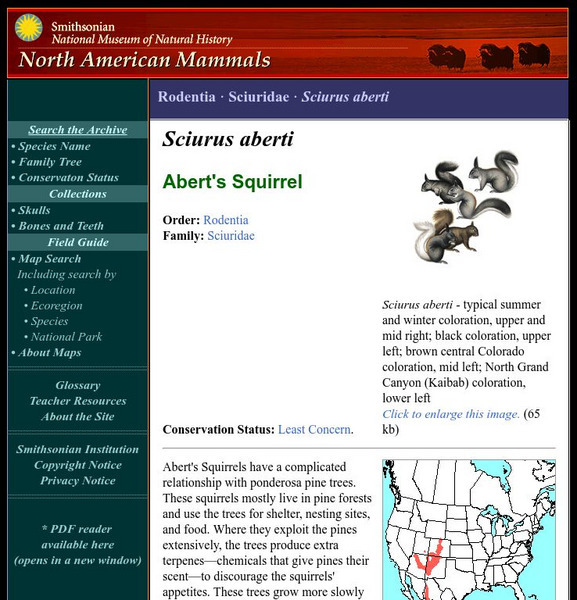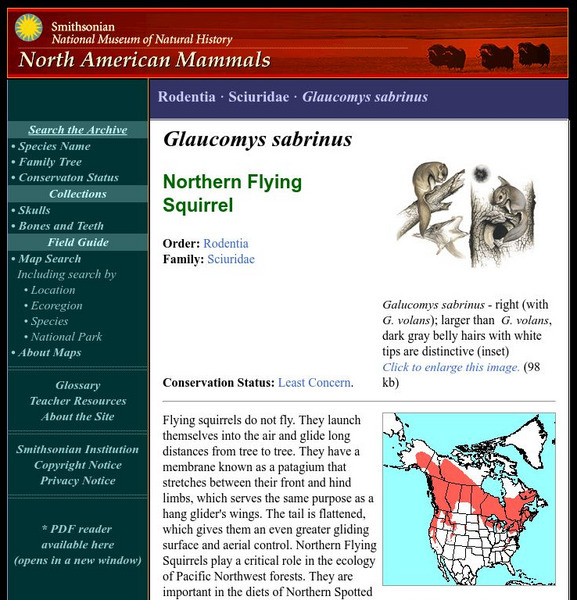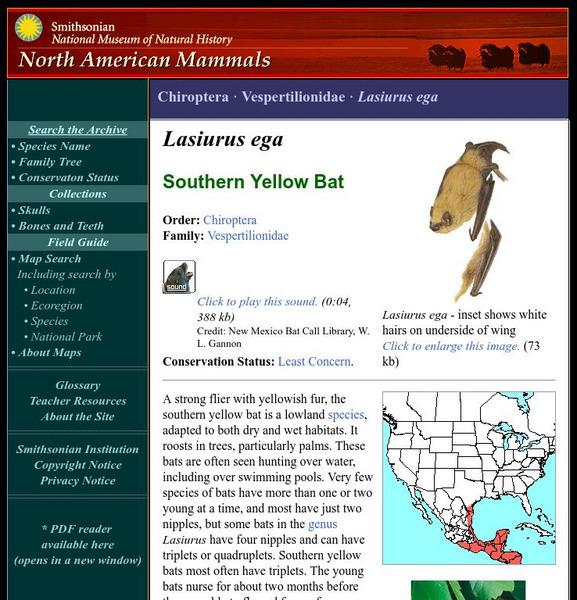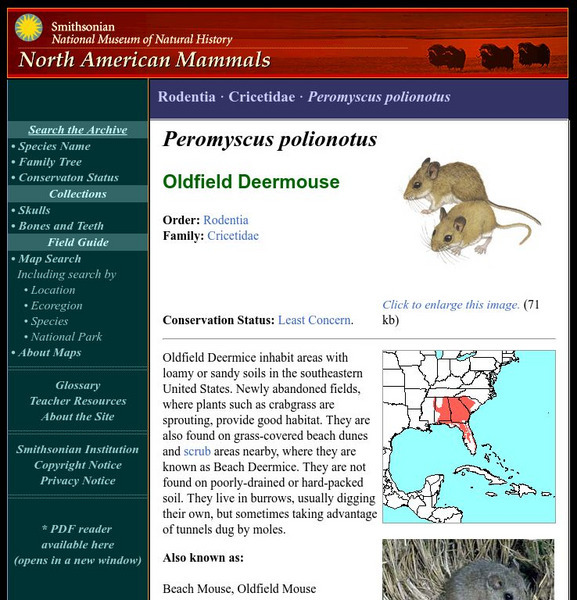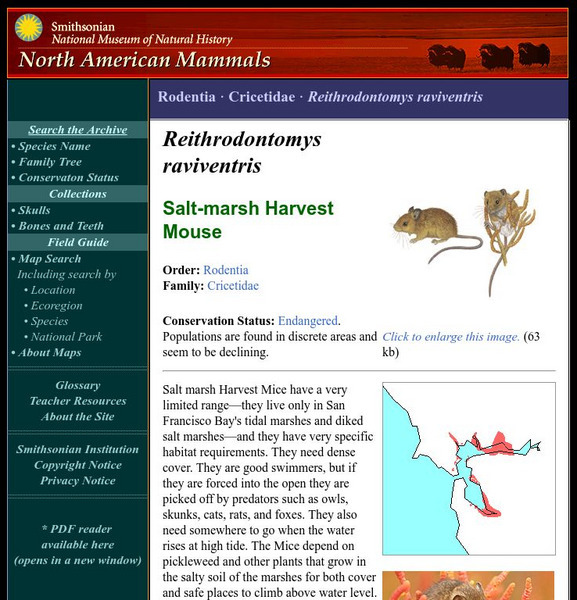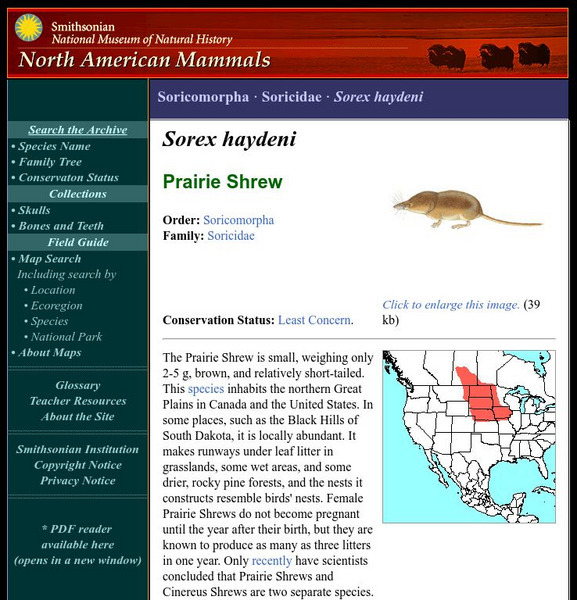Smithsonian Institution
National Museum of Natural History: American Mammals: Abert's Squirrel
Abert's Squirrels have a complicated relationship with ponderosa pine trees. These squirrels mostly live in pine forests and use the trees for shelter, nesting sites, and food. Learn more about the Sciurus aberti, more commonly known as...
Smithsonian Institution
National Museum of Natural History: American Mammals: Richardson's Collared Lemming
Richardson's Collared Lemmings are active 24 hours a day. They are found in tundra, and avoid marshy habitats and forested areas. Learn more about the Dicrostonyx richardsoni, more commonly known as a Richardson's Collared Lemming, in...
Smithsonian Institution
National Museum of Natural History: American Mammals: Agile Kangaroo Rat
Agile Kangaroo Rats are excellent swimmers. They can run on all four feet as well as hop on their large hind feet, and if they are fleeing a predator, can make sharp turns. Learn more about the Dipodomys agilis, more commonly known as an...
Smithsonian Institution
National Museum of Natural History: American Mammals: Northern Flying Squirrel
Flying squirrels do not fly. They launch themselves into the air and glide long distances from tree to tree. Learn more about the Glaucomys sabrinus, more commonly known as a Northern Flying Squirrel, in this easy-to-read species...
Smithsonian Institution
National Museum of Natural History: American Mammals: Southern Yellow Bat
A strong flier with yellowish fur, the southern yellow bat is a lowland species, adapted to both dry and wet habitats. It roosts in trees, particularly palms. Learn more about the Lasiurus ega, more commonly known as a Southern Yellow...
Smithsonian Institution
National Museum of Natural History: American Mammals: Sagebrush Vole
Sagebrush Voles usually live in colonies in semiarid, partly brushy habitat. The dominant plants where they live are sagebrush or rabbitbrush mixed with bunchgrass. Learn more about the Lemmiscus curtatus, more commonly known as a...
Smithsonian Institution
National Museum of Natural History: American Mammals: Margay
Margays are small spotted cats that closely resemble ocelots, but are about half the size and lack the ocelot's two prominent black cheek stripes. Margays are forest-dwellers and good climbers and jumpers, so agile that captives have...
Smithsonian Institution
National Museum of Natural History: American Mammals: Vancouver Marmot
Vancouver Marmots live only on Vancouver Island, British Columbia. They are the only endangered mammal in Canada, with a population estimated at only 100-200 individuals. Learn more about the Marmota vancouverensis, more commonly known...
Smithsonian Institution
National Museum of Natural History: American Mammals: Sei Whale
Unlike other rorquals, Sei whales have a dolphin-like dorsal fin. They are also unusual in using two different methods to fill their mouths with water during feeding - they both gulp and skim-feed. Learn more about the Balaenoptera...
Smithsonian Institution
National Museum of Natural History: American Mammals: Seminole Bat
Seminole bats, sometimes called mahogany bats, can be mistaken for red bats where the two species overlap (the red bat has a much larger range). The two are similar in color, size, and appearance. Learn more about the Lasiurus seminolus,...
Smithsonian Institution
National Museum of Natural History: American Mammals: Pale Kangaroo Mouse
Most Pale Kangaroo Mice live in high, cold desert in Nevada; there is also a small population in eastern California. They look like small kangaroo rats, and like them, can hop on their large hind feet. Learn more about the Microdipodops...
Smithsonian Institution
National Museum of Natural History: American Mammals: Southern Plains Woodrat
Southern Plains Woodrats are found in places where grasses, creosotebush, mesquite, and cactus grow. Local populations can reach high levels and then crash. Learn more about the Neotoma micropus, more commonly known as a Southern Plains...
Smithsonian Institution
National Museum of Natural History: American Mammals: Mearn's Grasshopper Mouse
Grasshopper Mice are adapted to a predatory lifestyle. Their molar teeth have high-cusped shearing surfaces for puncturing and slicing, and their biting strength is increased through enlarged muscle attachments on the lower jaw and...
Smithsonian Institution
National Museum of Natural History: American Mammals: Merriam's Pocket Mouse
Merriam's Pocket Mice are found in short-grass prairie, desert scrub, and open, arid brushland. They are most common where the vegetation is dense enough to provide them with seeds and some protection from predators, but not so dense...
Smithsonian Institution
National Museum of Natural History: American Mammals: Texas Mouse
Texas Mice need rocky environments. Where these occur, they are found in cedar glade, juniper-grass, and oak-juniper forests. Learn more about the Peromyscus attwateri, more commonly known as a Texas Mouse, in this easy-to-read species...
Smithsonian Institution
National Museum of Natural History: American Mammals: Mesquite Mouse
Mesquite Mice live in dense mesquite thickets known as bosques. Although mesquite is the dominant plant in bosques, other desert plants such as palo-verde, prickly pear, and cholla cacti, and grasses, mix with the mesquite. Learn more...
Smithsonian Institution
National Museum of Natural History: American Mammals: White Footed Mouse
The White-footed Mouse has a very wide distribution. It is the most abundant rodent in mixed deciduous and coniferous forests in the eastern United States, and is probably equally abundant near farms. Learn more about the Peromyscus...
Smithsonian Institution
National Museum of Natural History: American Mammals: Northwestern Deermouse
Keen's Deermouse is the most common deermouse in the Pacific Northwest. It inhabits rainy, mild climate zones at higher elevations than the closely-related Deermouse (Peromyscus maniculatus), and prefers areas where the forest canopy is...
Smithsonian Institution
National Museum of Natural History: American Mammals: Northern Long Eared Myotis
Although the northern long-eared myotis is common and widespread, much remains to be learned about its roosting habits, reproduction, and longevity. This bat is known to hibernate in caves and mines and to roost under tree bark. Learn...
Smithsonian Institution
National Museum of Natural History: American Mammals: Oldfield Mouse
Oldfield Mice inhabit areas with loamy or sandy soils in the southeastern United States. Newly abandoned fields, where plants such as crabgrass are sprouting, provide good habitat. Learn more about the Peromyscus polionotus, more...
Smithsonian Institution
National Museum of Natural History: American Mammals: Salt Marsh Harvest Mouse
Salt-marsh Harvest Mice have a very limited range, they live only in San Francisco Bay's tidal marshes and diked salt marshes and they have very specific habitat requirements. They need dense cover. Learn more about the Reithrodontomys...
Smithsonian Institution
National Museum of Natural History: American Mammals: Western Harvest Mouse
Western Harvest Mice are adaptable, widespread, and abundant, especially in meadows, prairies, old pastures, stream valleys, and marshes. They eat seeds, insects, and plants. Learn more about the Reithrodontomys megalotis, more commonly...
Smithsonian Institution
National Museum of Natural History: American Mammals: Prairie Shrew
The Prairie Shrew is small, weighing only 2-5 g, brown, and relatively short-tailed. This species inhabits the northern Great Plains in Canada and the United States. Learn more about the Sorex haydeni, more commonly known as a Prairie...
Smithsonian Institution
National Museum of Natural History: American Mammals: Long Tailed Shrew
The Long-tailed Shrew probably uses its long tail for balance when it is climbing among the rocks or boulders that are always present where it lives. It spends almost all its time underground, and was, until recently, thought to be...
